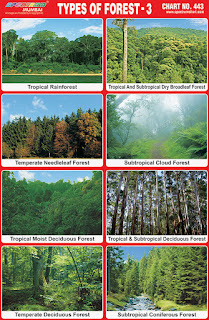 |
| Types of Forest 3 Chart |
Spectrum Chart - 443 : Types of Forest 3
1. Tropical Rainforest - Tropical
rainforests occur in areas of tropical rainforest climate in which
there is no dry season all months have an average precipitation value
of at least 60 mm. Tropical rainforests exhibit high levels of
biodiversity. Around 40% to 75% of all biotic species are indigenous
to the rainforests. Rainforests are home to half of all the living
animal and plant species on the planet. Two-thirds of all flowering
plants can be found in rainforests.
2. Tropical and Subtropical Dry Broadleaf
Forest – The tropical and subtropical dry broadleaf forest biome is
located at tropical and subtropical latitudes. Though these forests
occur in climates that are warm year-round, and may receive several
hundred centimetres of rain per year, they have long dry seasons
which last several months and vary with geographic location. These
seasonal droughts have great impact on all living things in the
forest.
3. Temperate Needleleaf Forest - Temperate
needleleaf forests mostly occupy the higher latitude regions of the
northern hemisphere, as well as high altitude zones and some warm
temperate areas, especially on nutrient-poor or otherwise
unfavourable soils. These forests are composed entirely or nearly so
of coniferous species. Needleleaf forests grow mainly in regions that
have long, cold winters.
4. Subtropical Cloud Forest –
Subtropical Cloud Forest receives as much as 40% of their
precipitation from moisture that condenses on the leaves of trees
from mist and clouds that move through these upland forests.
Subtropical cloud forests occur on high mountains in the tropics most
commonly between 3,000 and 4,000 feet elevation.
5. Tropical Moist Deciduous Forest -
Tropical moist deciduous forests covers an area receiving
sufficiently high rainfall (100 to 200 cm) spread over most parts of
the year. The dry periods are of short duration. Many plants of such
forests show leaf-fall in hot summer.
6. Tropical & Subtropical Deciduous
Forest - Tropical & subtropical deciduous forest thrive where the
rainfall is between 70 cm to 200 cm. The trees in these forest shed
their leaves for about six to eight weeks in summer.
7. Temperate
Deciduous Forest - Temperate deciduous forests are dominated by trees
that lose their leaves each year. They are found in areas with warm,
moist summers and mild winters. Many species that are typical of
these forests time their growth and flowering to the short period
just before the canopy opens hence they are known as spring
ephemerals. Many migratory birds time their arrival to coincide with
the opening of the canopy, which provides the insects that are their
principal food sources for raising young.
8. Subtropical Coniferous Forest -
Subtropical coniferous forests are characterised by diverse species
of conifers, whose needles are adapted to deal with the variable
climatic conditions. These biomes feature a thick, closed canopy
which blocks light to the floor and allows little underbrush. As a
result, the ground is often covered with fungi and ferns. Shrubs and
small trees compose a diverse understory. Mexico harbours the world's
richest and most complex subtropical coniferous forests.

No comments:
Post a Comment